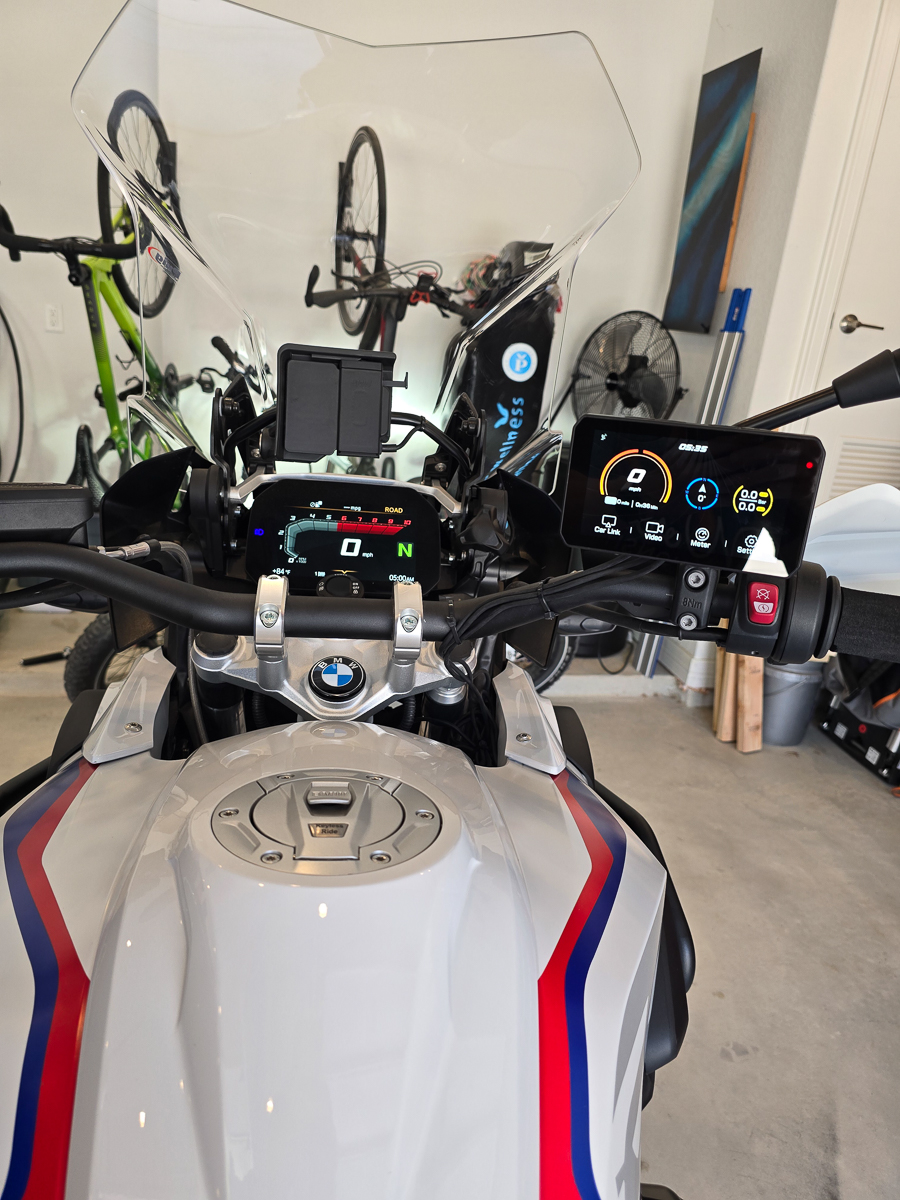
REVIEW—I love using Android Auto in my car. I use it to listen to Audible books, take phone calls, and use Google Maps. In the past year or so, I have seen devices you can add to your car to allow Android Auto or Apple CarPlay for older autos without that newer technology. Well, now there are these same devices available for motorcycles, and I am excited! One of these devices, made by Chigee, is called the AIO-5 Lite and I am lucky enough to get a chance to review it.
What is it?
The Chigee AIO-5 Lite is a five-inch touchscreen display with wireless Android Auto and Apple CarPlay. It comes with two cameras (one for the front and one for the rear of your bike) and a GPS antenna. It has optional accessories like a tire pressure monitoring system and remote controls.
What’s included?
- Host *1;Camera*2
- Mounting Bracket*1;Ball Head Component*1
- Power Cable*1; Magic Tie*2;Nylon Tie*5
- Disassembly Tool*3;Stickers*2
- Step Rings*3;Splicing Buckles*2;External GPS*1
- User manual
- key chain
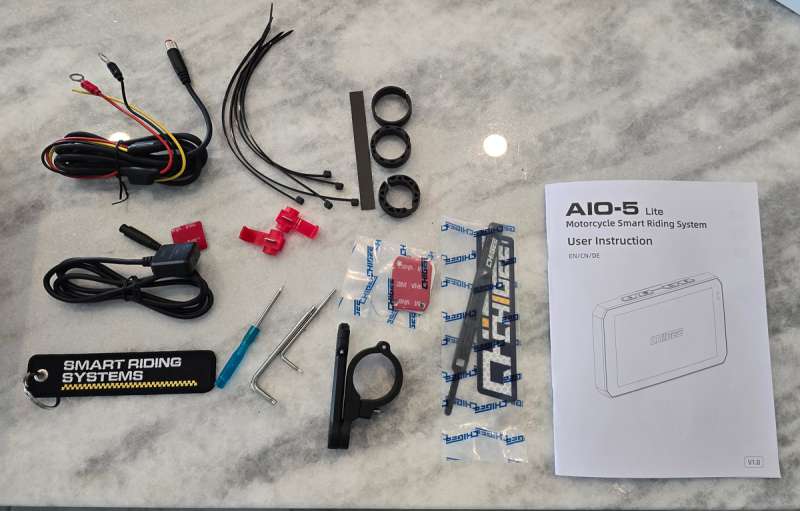
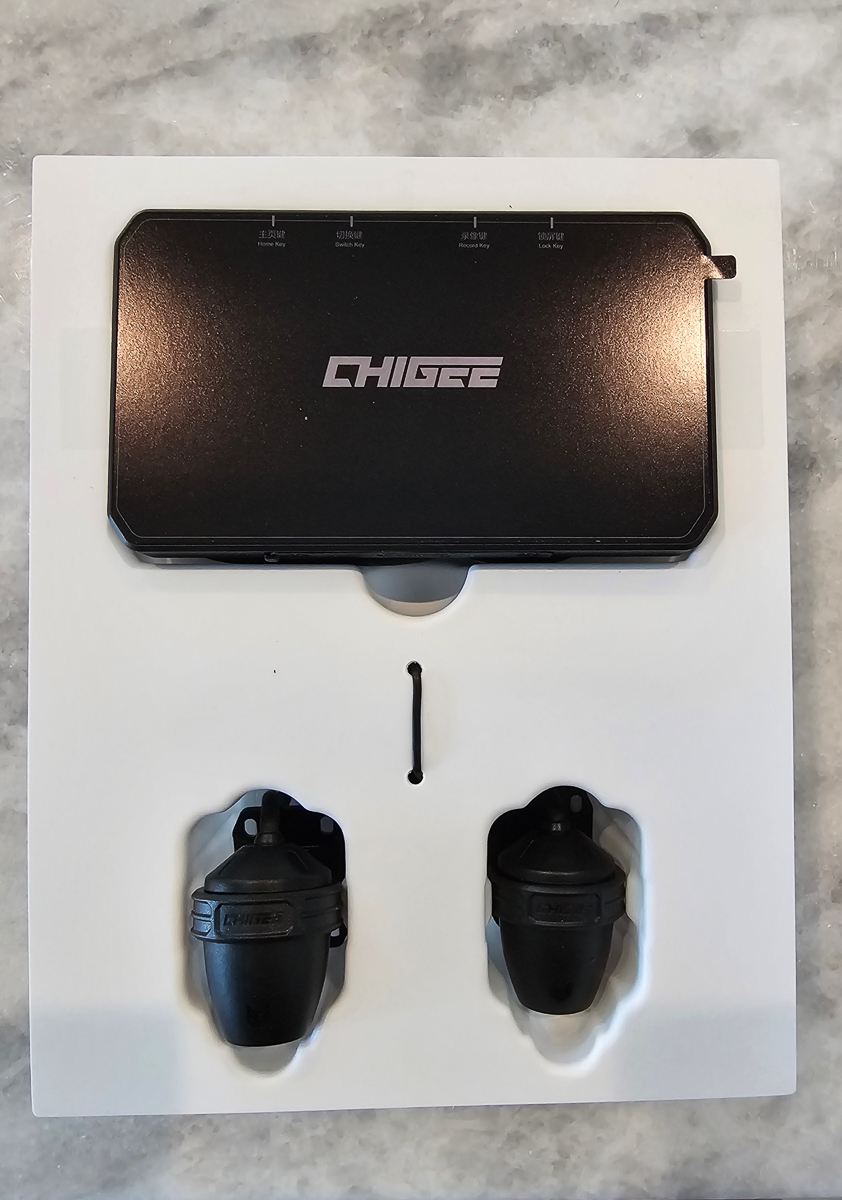
I also received the CGRC Remote Control CAN for BMW and the mirror mount kit which are optional accessories.
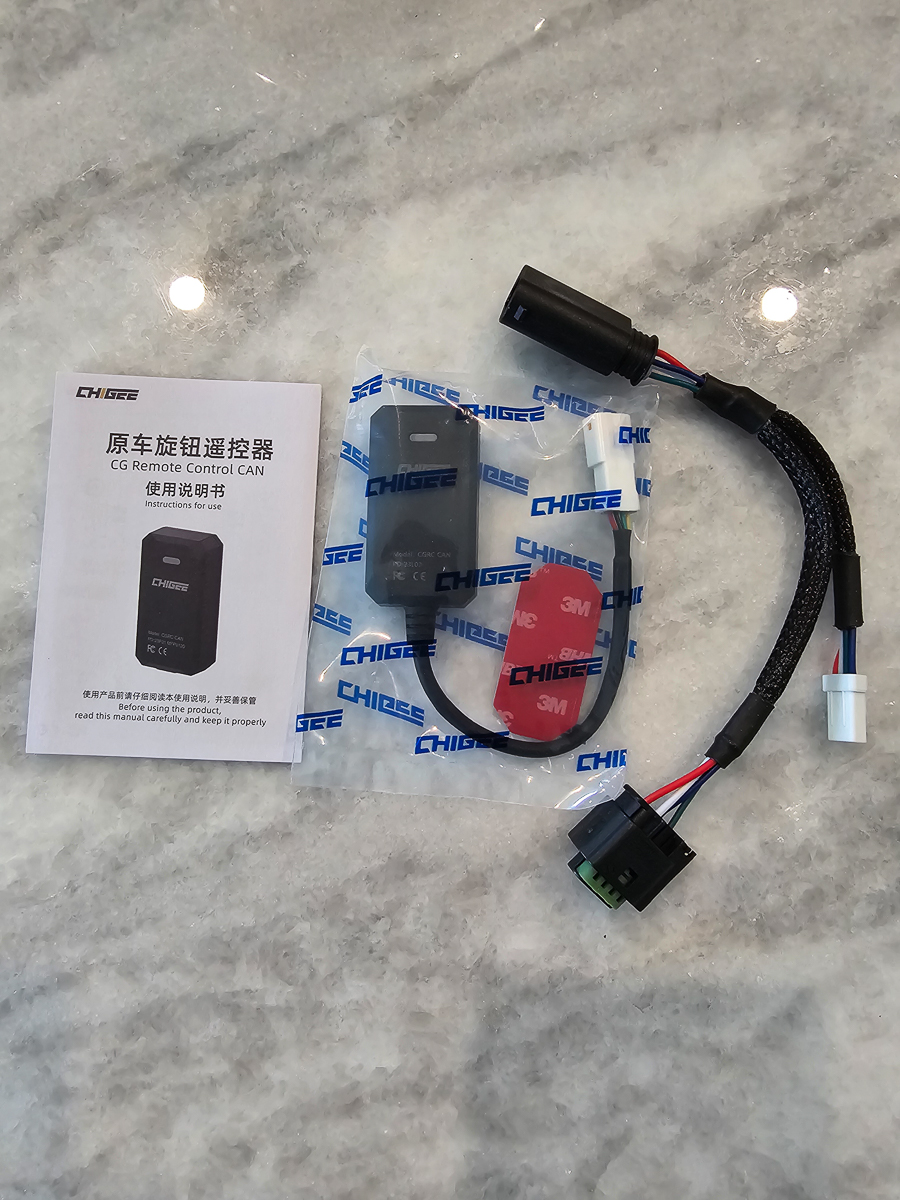
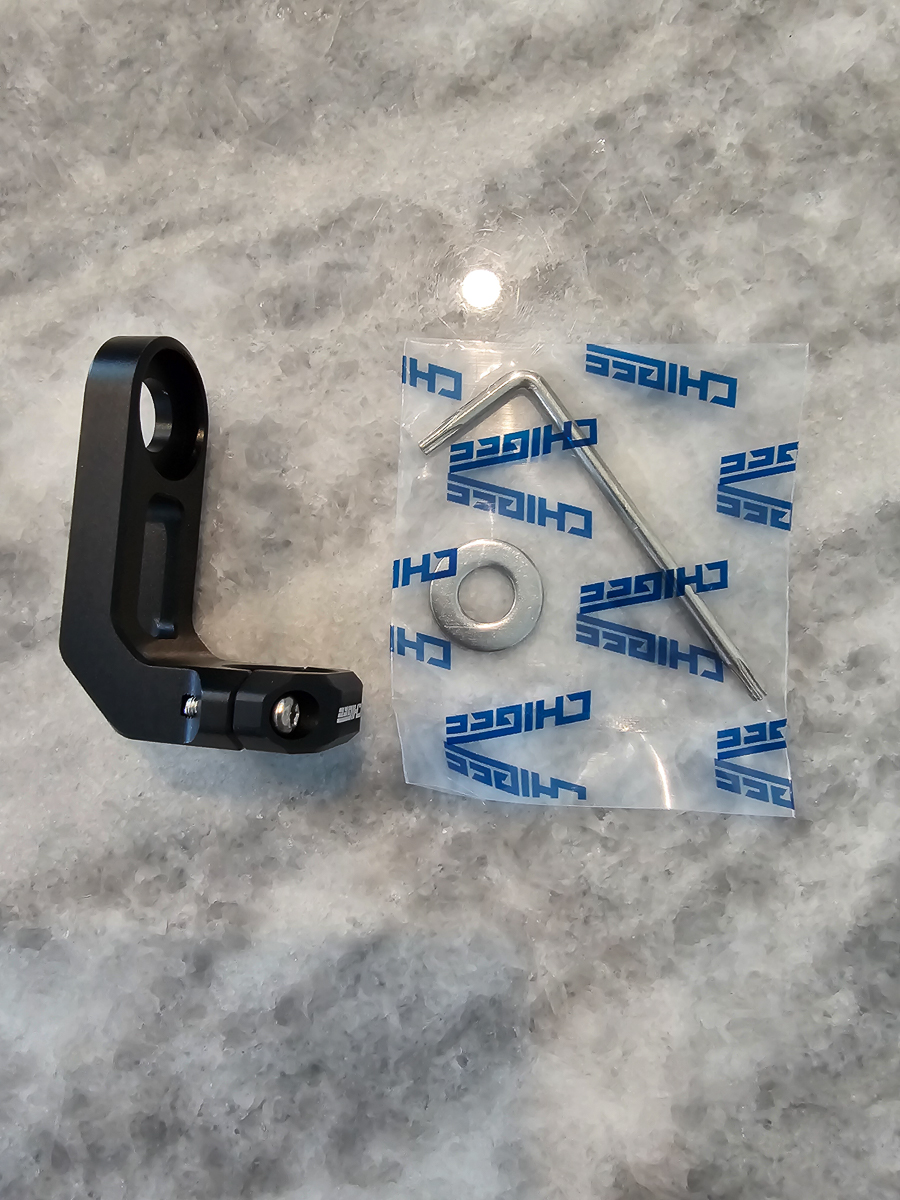
Tech specs
Click to expand
- 【Tailored For Motorcycles Wireless Apple CarPlay】The CHIGEE AIO-5 Lite Motorcycle Carplay shields against extreme heat and impacts. It features CarPlay and Android Auto compatibility and offers live updates on maps and traffic at no extra charge. This device enables simultaneous music control and navigation viewing, plus hands-free call and message handling. Equipped with Wi-Fi and Bluetooth, it elevates your ride, ensuring connectivity and entertainment without compromising safety.
- 【BLIND SPOT DETECTION】The AIO-5 motorcycle action camera has a radar detector for BSD functionality. It can receive gentle audible warnings and red flashing borders on the screen when objects approach the left or right blind spots, preventing accidents caused by lane changes.This system is particularly useful during low-visibility conditions such as night driving or inclement weather.
- 【STARVIS & HDR/WDR】The Motorcycle dash cam front and rear 1080P cameras are enhanced by the IMX307 SONY sensor STARVIS for superior low-light performance. It ensures clear, noise-reduced images even in dim conditions. The HDR function adjusts for brightness, making it ideal for recording detailed itineraries and handling sudden light changes, such as entering tunnels or in backlight situations.
- 【LCD Touch Screen & Anti-Touch Mode】The AIO-5 Lite features a 5-inch ultrabright IPS LCD touchscreen with up to 1200cd/m² brightness, designed for clear visibility and easy operation, even with motorcycle gloves. Its fully fitted, waterproof, and anti-condensation screen ensures smooth usage. The device includes an automatic brightness adjustment for optimal viewing in any light condition and a lock function to prevent accidental touches, which is particularly useful during rain.
- 【Dual Bluetooth & Voice control & WIFI】The device supports Bluetooth 5.0 and voice control, enhancing driving convenience and safety. It allows for hands-free voice commands through BT earphones/intercom for navigation, refueling prompts, and music control, promoting safe driving practices by minimizing distractions.
- 【IP67 Waterproof & Easy To Install】The AIO-5 Lite offers IP67 waterproofing, suitable for tough environments. It endures extreme temperatures from 70°C to -20°C. Its design emphasizes heat dissipation with a steel alloy frame for durability and a floating structure for stability, ensuring reliable performance in various conditions. The Motorcycle GPS Navigation System’s specially designed bracket kit and screw system make it easy to mount the screen on any motorcycle.
Design and features
The AIO-5 Lite comes with two cameras. Those cameras will record 29GB of internal storage, but installing a microSD card will record to the card instead. The card slot is on the bottom edge of the main display screen behind a rubber cover held in place with two very small Torx screws. I used the included torx key provided in the kit to remove only the right screw, and that exposed the microSD card slot and a USB-C slot.
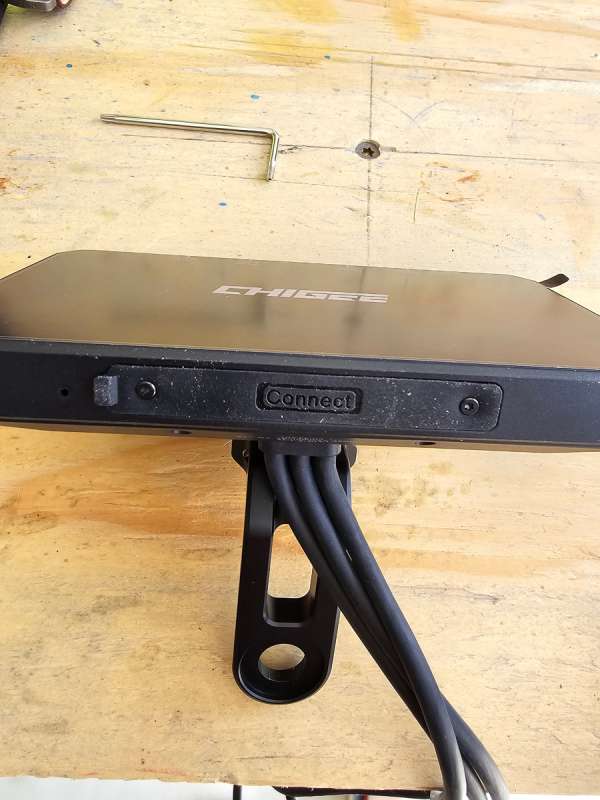
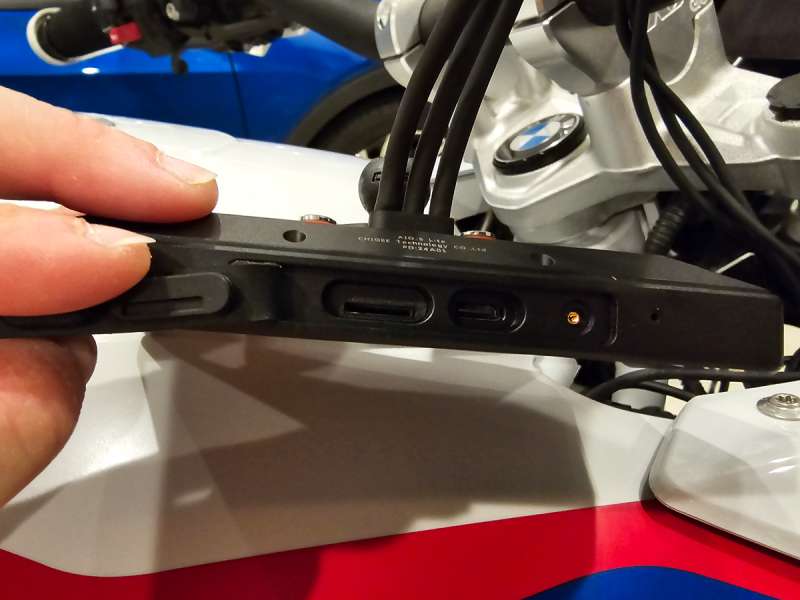
On the top edge of the display are four buttons. From left to right, they are:
- The home key button puts you back on the main display, which will show your speed, direction, and tire pressure readings if the TPMS is installed. The display also links to Android Auto/Apple CarPlay, camera feeds, motorcycle info, and settings.
- When pressed, the switch key will take you to the connected phone’s Android Auto or Apple CarPlay display. Pressing this button again will switch to the motorcycle information page, which shows RPM and battery voltage.
- Video button—The front camera display will appear when you first press it. If the rear camera is installed, a small button will appear to the right, letting you switch views between the front and rear cameras.
- Lock key – a short press will turn off the screen, press for two seconds, and lock the screen to prevent any touches from activating it; pressing for six seconds will force the unit to restart.
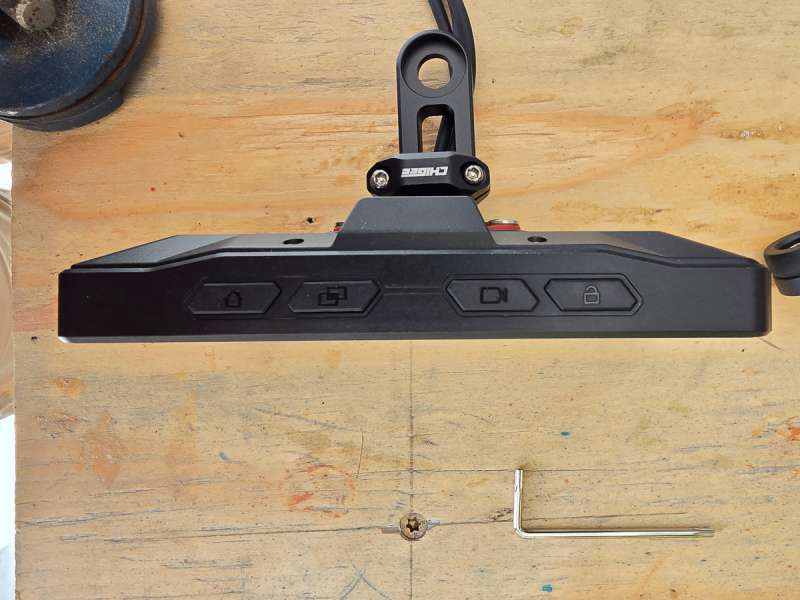
Below is a picture of the home screen. I am inside my garage and do not have the TPMS installed, so it displays no readings.
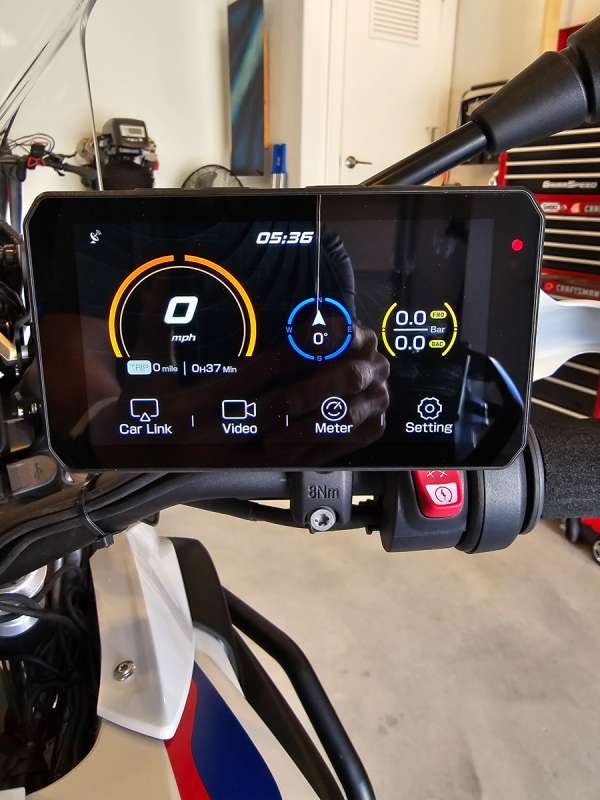
My cell phone is a Samsung Galaxy S24 Ultra. Once connected to the device (it connects within 30 seconds of powering on), pressing the switch key shows the Android Auto home page. This page matches what is shown in my car. I have Google Maps on the left with quick directions on the top right. On the bottom right is the Audible display.
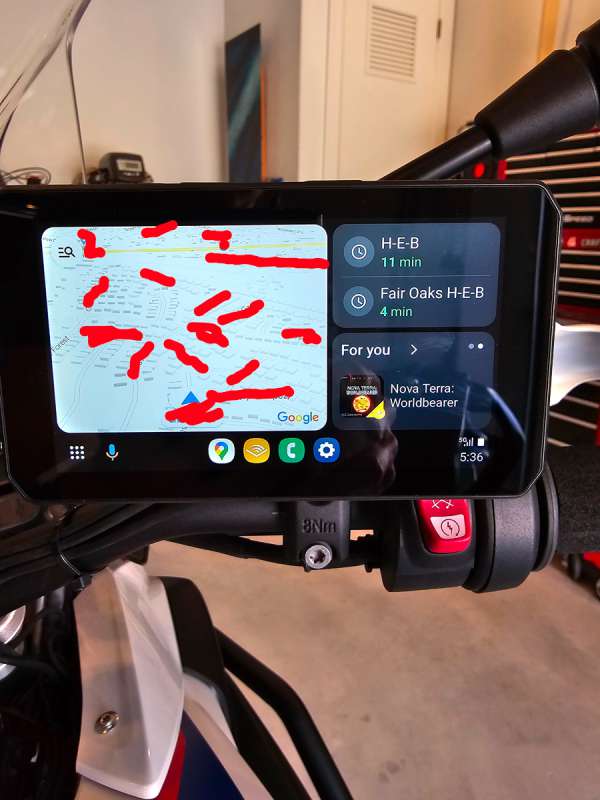
The next two pictures show the front and rear camera displays. In the second picture, you can see the button on the right side of the display that will let you switch between the front and rear cameras. Another nice feature is shown in the second picture of the rear camera. If you touch the display when the front or rear camera is shown, you are presented with the five buttons along the bottom of the screen. The first button, which looks like a camera, will force the device to take a snapshot of the current display. The file folder button will take you to the folders where you can view the stored pictures and videos. From that screen, you can scroll through a single video and delete any picture or video. You do not have to have the app installed to see the videos, which I think is nice. The middle button will force you to stop recording and start a new recording. The lock button will lock the current video and prevent it from being overridden by loop recording. The only way to eliminate a locked video is to delete it from the folder screen, through the app, or by formatting the SD card. The last button will take you to video-specific settings.
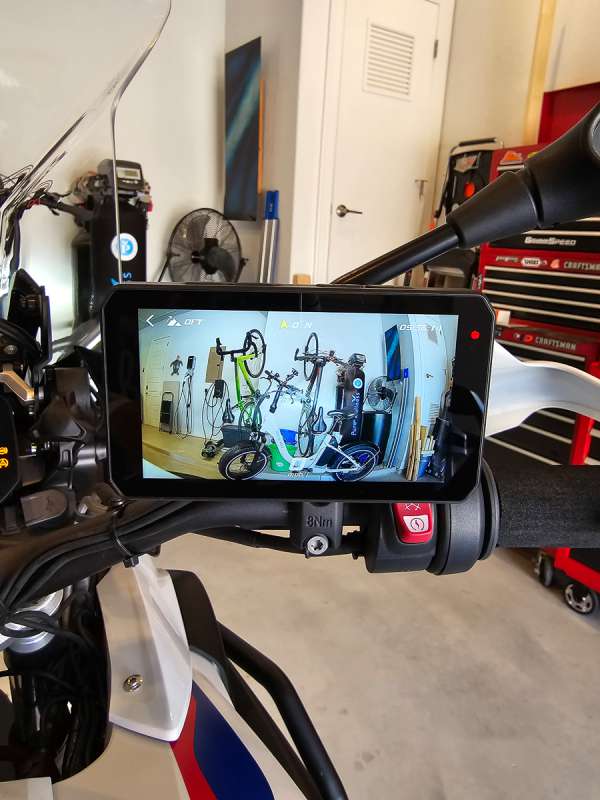
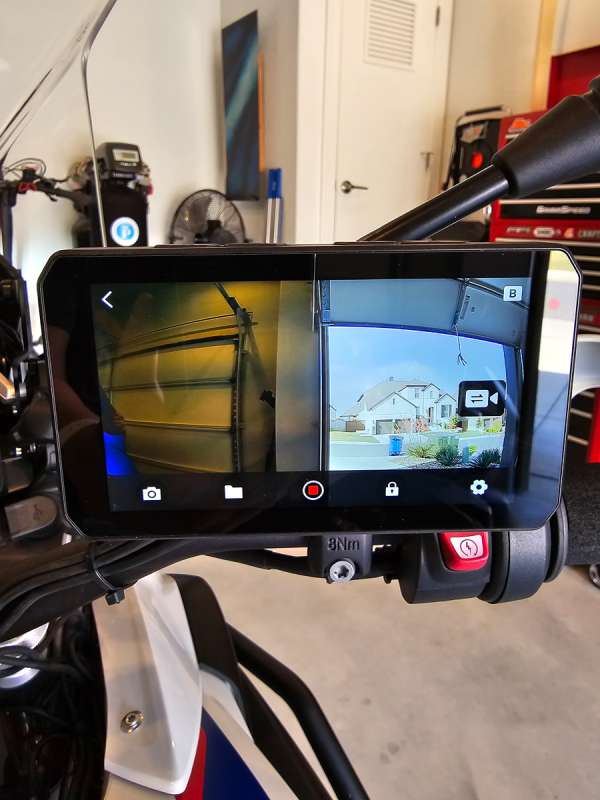
When you click the settings button from the home window, you are presented with the screen below.
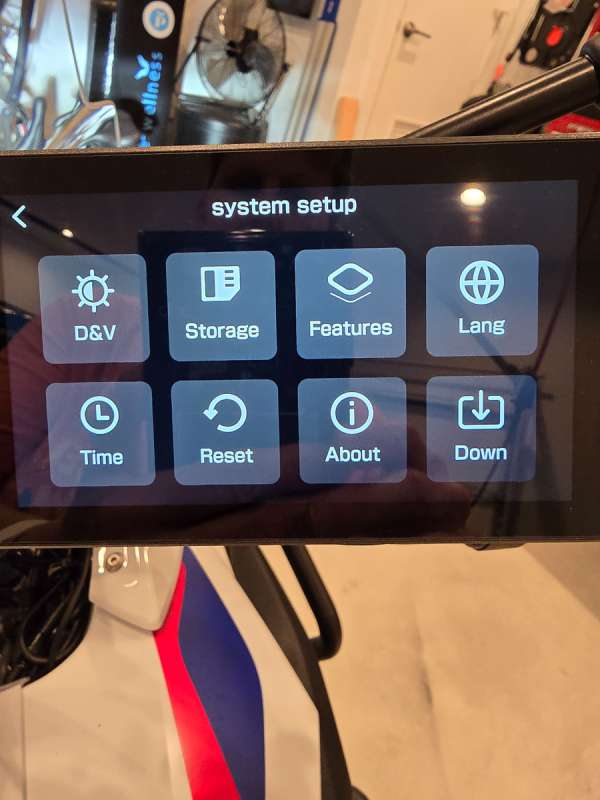
The storage button will show you the amount of used and available storage from the on board 28GB and and SD card you have installed.
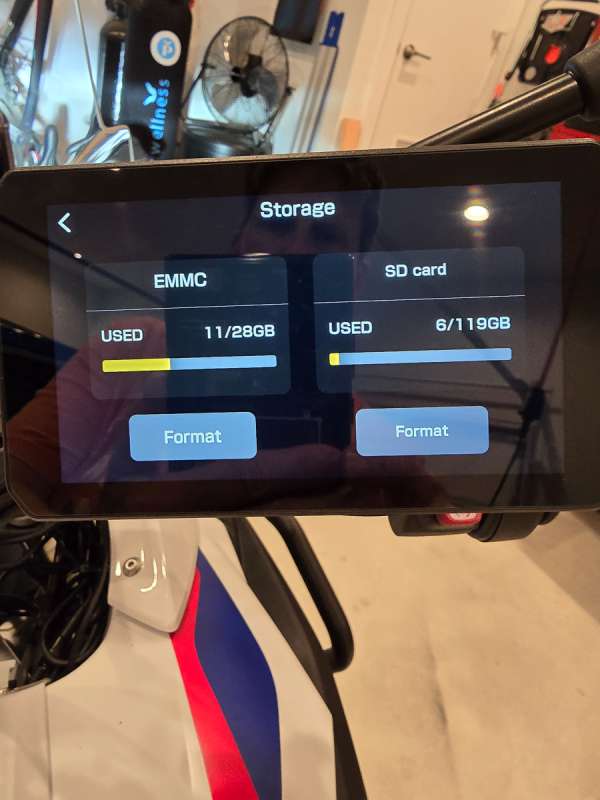
The display and volume screen has the settings for the display. I currently have it set to auto brightness and a plain black background.
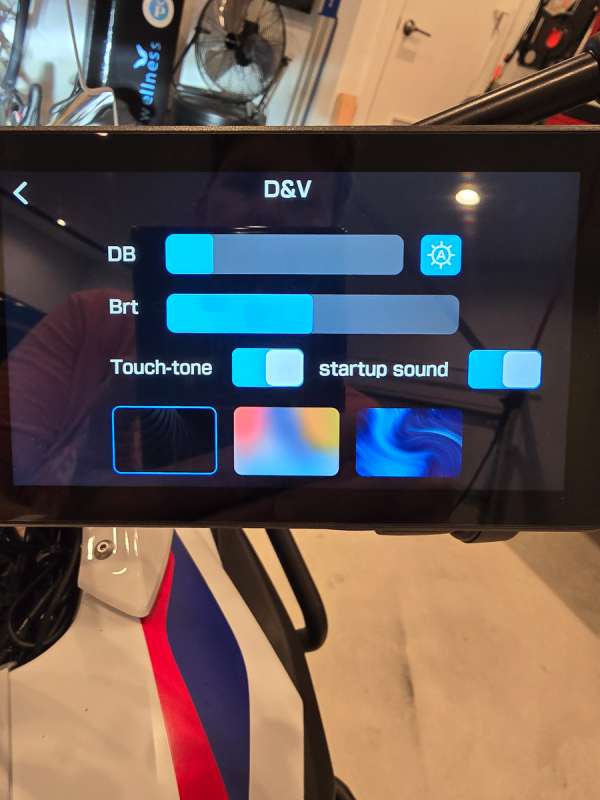
The features screen gives you access to the remote sensors. If you have a headset in your helmet, the headset screen specifies the headset should be connected to your phone and not directly to the AIO-5 Lite.
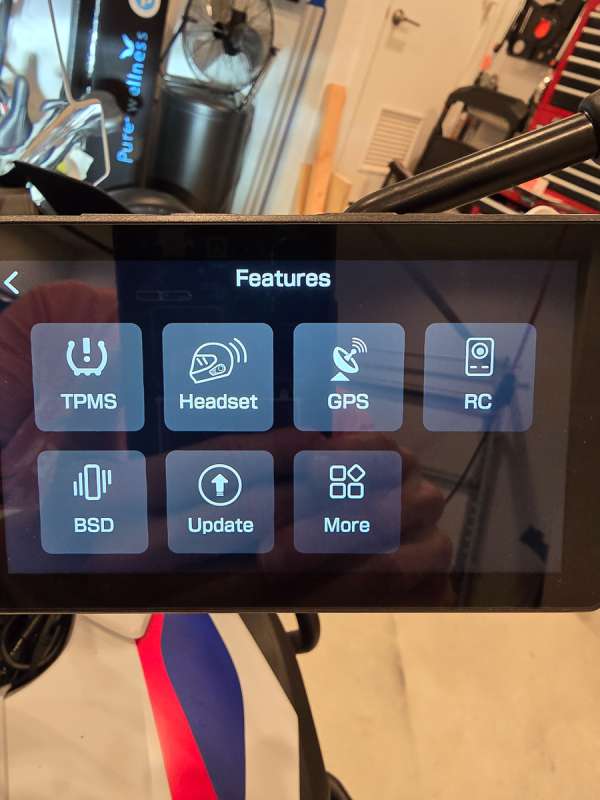
The RC screen is for the remote control. There are two options for a remote control with the AIO-5 Lite. There is a standard remote control that can be used with any bike and a remote control specific to BMW bikes. The BMW version connects directly to the CANbus system on the bike and lets you scroll through the items on the screen using the BMW ‘wonder wheel’ on the left side of the handlebar next to the left grip. My bike is a BMW R1250GS, and I have connected the BMW remote to it. It was automatically connected to the device. I did not have to do anything other than plug it into the harness in the tail of my motorcycle.
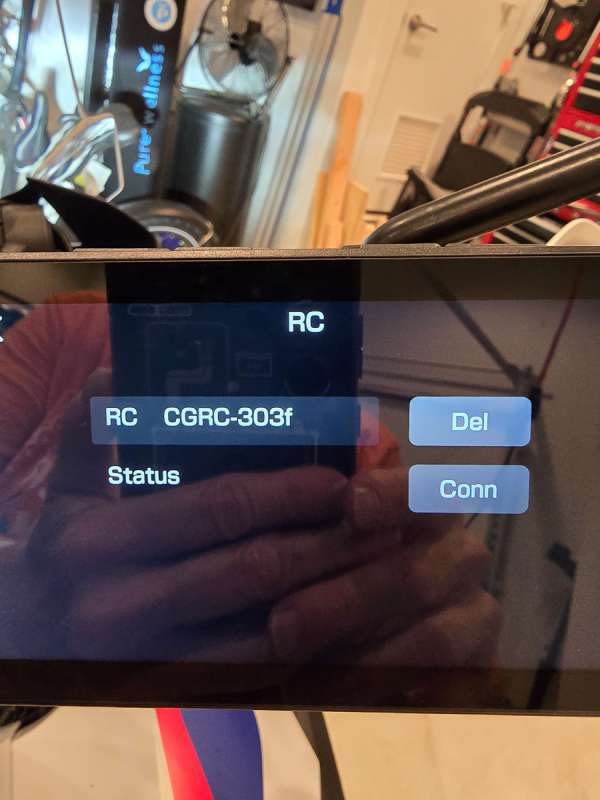
The next few screens show the settings for blind spot detection. You can turn it on or off and also turn on the calibration settings. This puts lines in the display so you can be sure your cameras are mounted in the correct position for blind spot detection. You want the red line to be 8 meters behind the motorcycle.
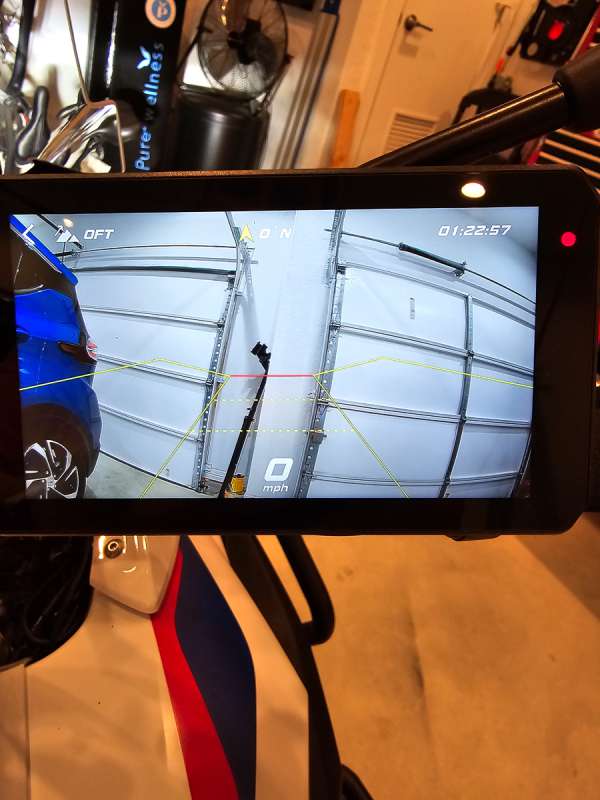
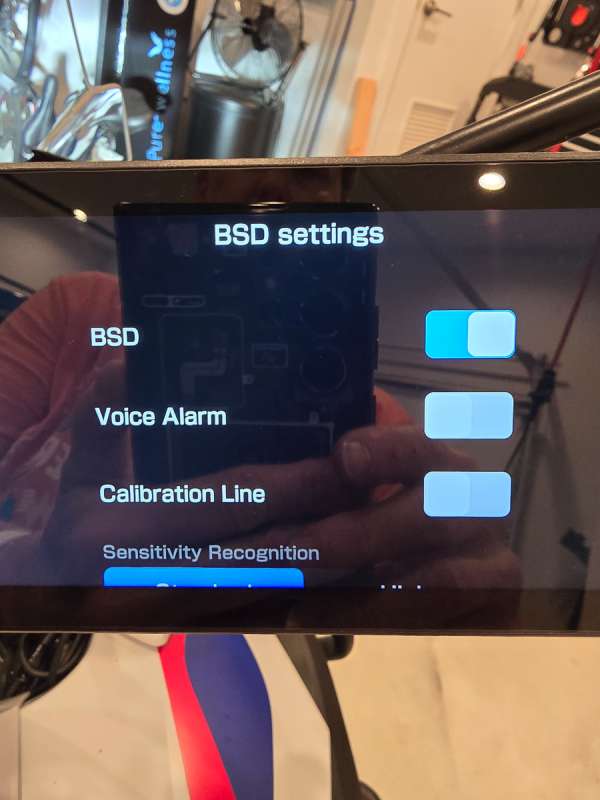
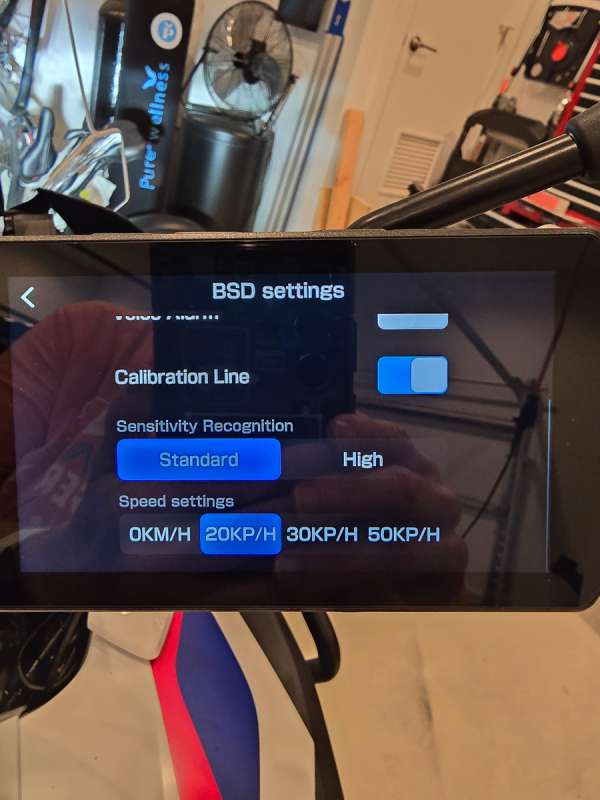
The “more” screen lets you change between metric and imperial displays. There is also a firmware update screen. The firmware will update via Wifi from a connected phone. This is a good thing because once the device is mounted to the bike, there is no easy way to remove it without disconnecting four lines and removing it from the mounting bracket.
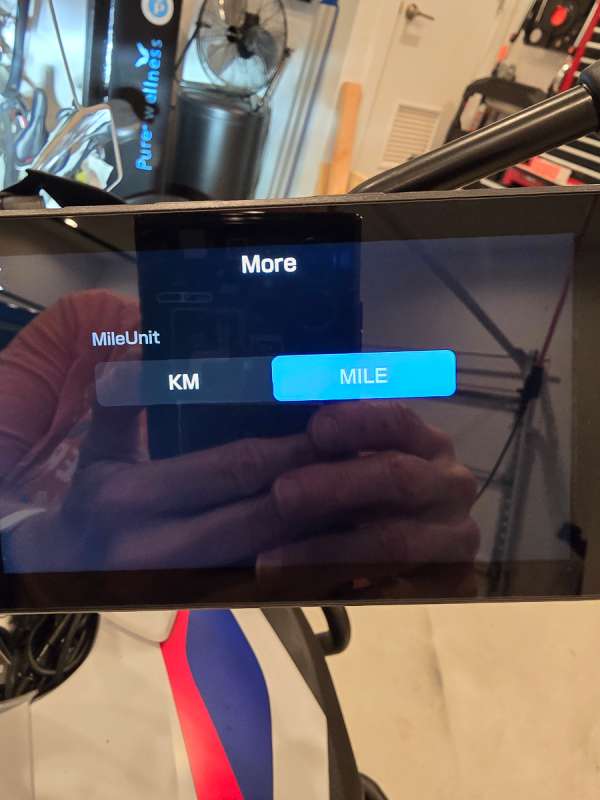
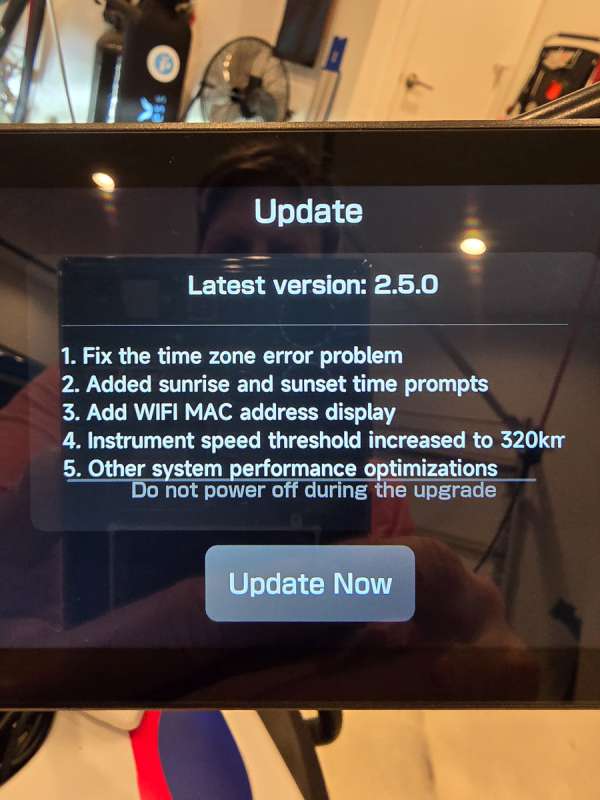
The next few pictures show you the screens for the video/camera settings. The Fus Out setting will let you merge the front and back camera videos into a single file if you wish. You can set the video length anywhere from one to three minutes.
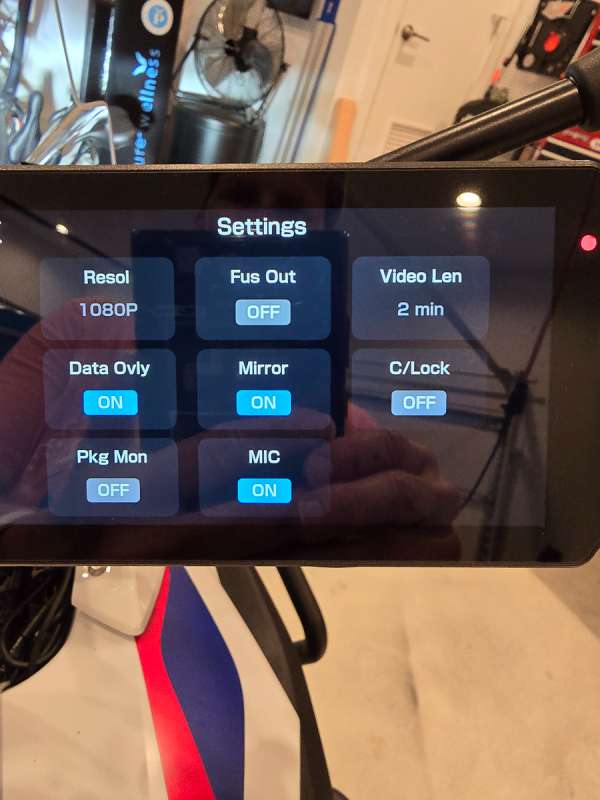
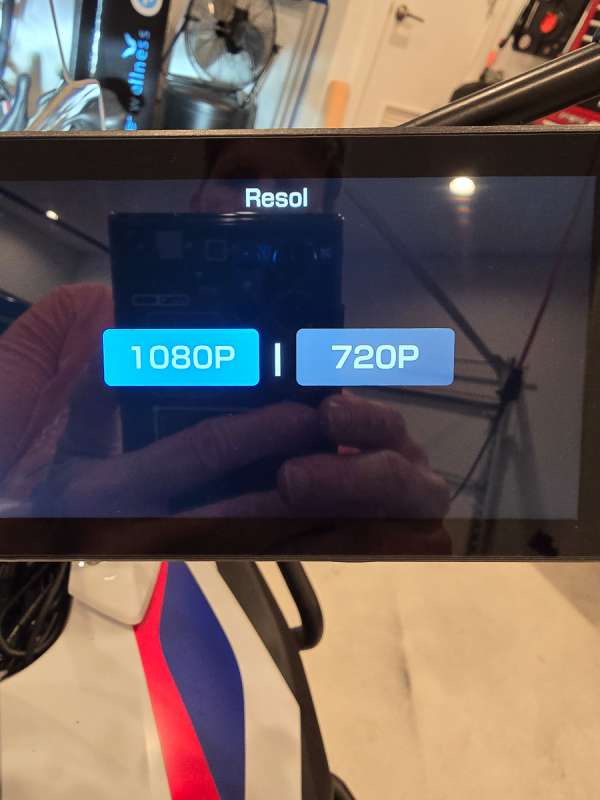
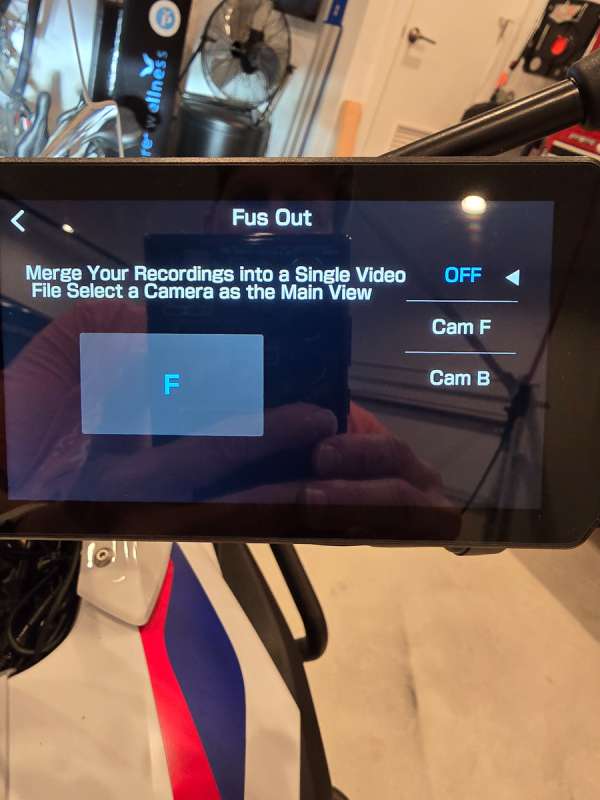
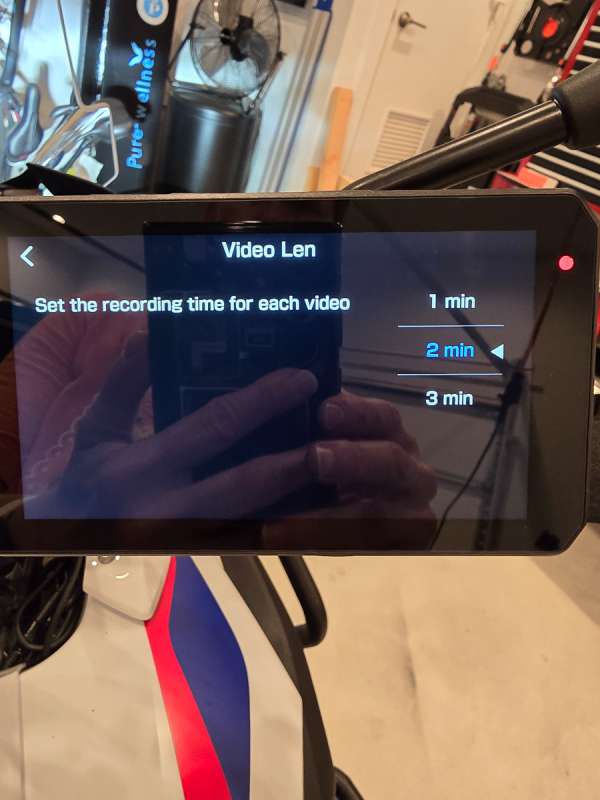
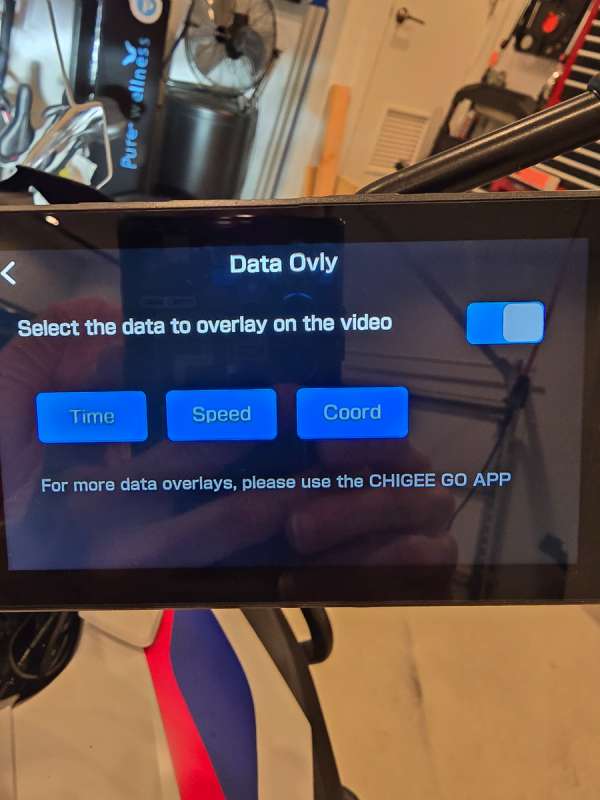
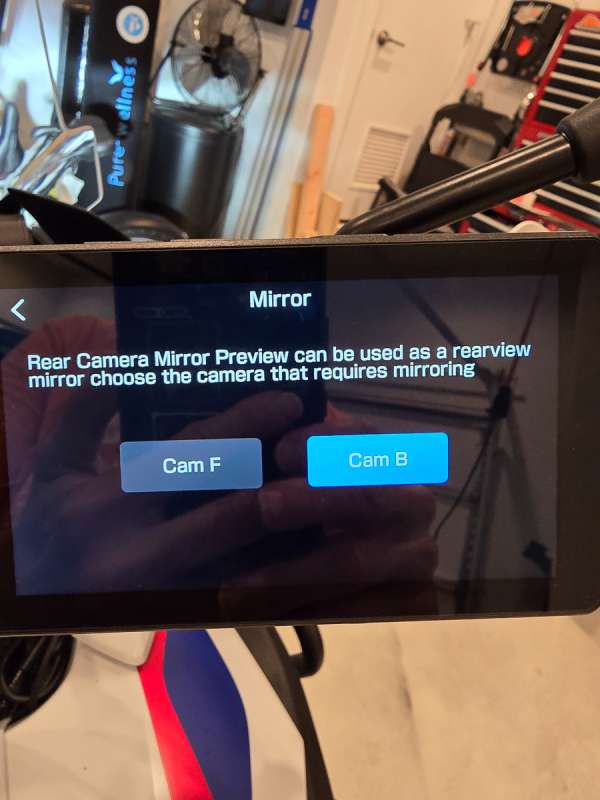
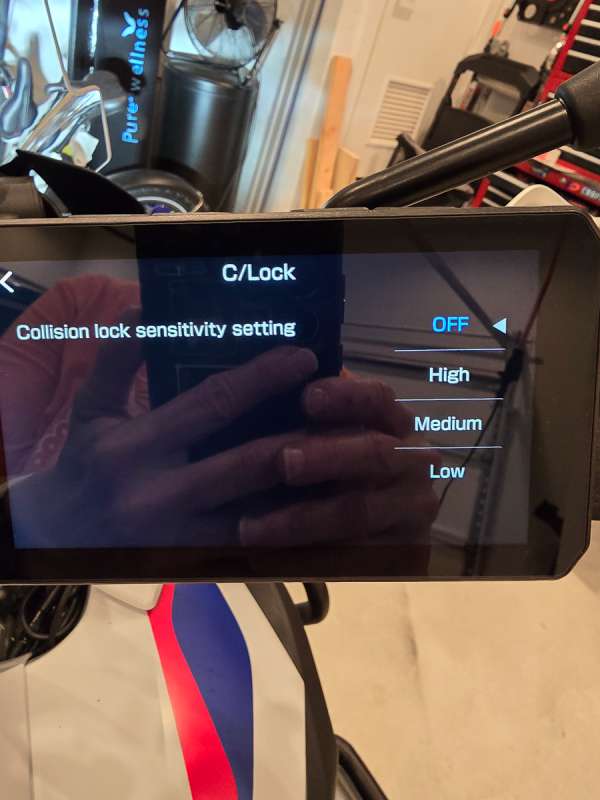
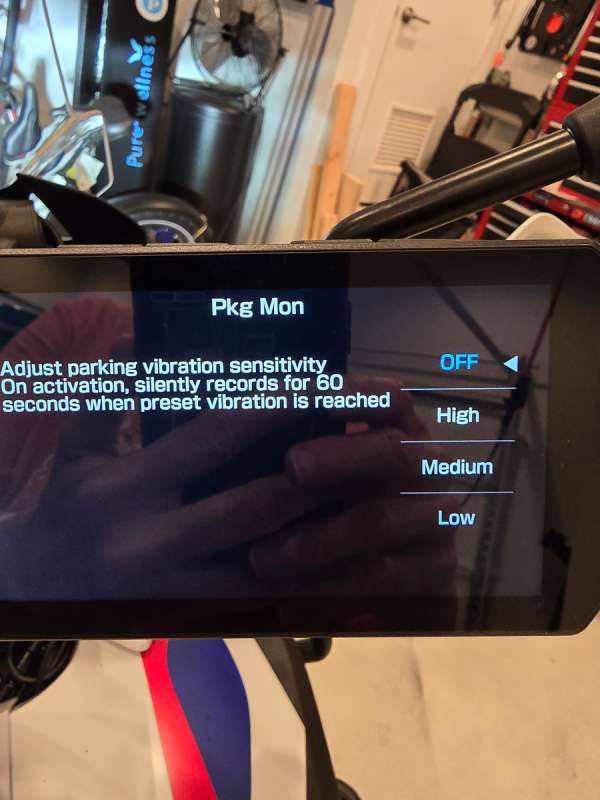
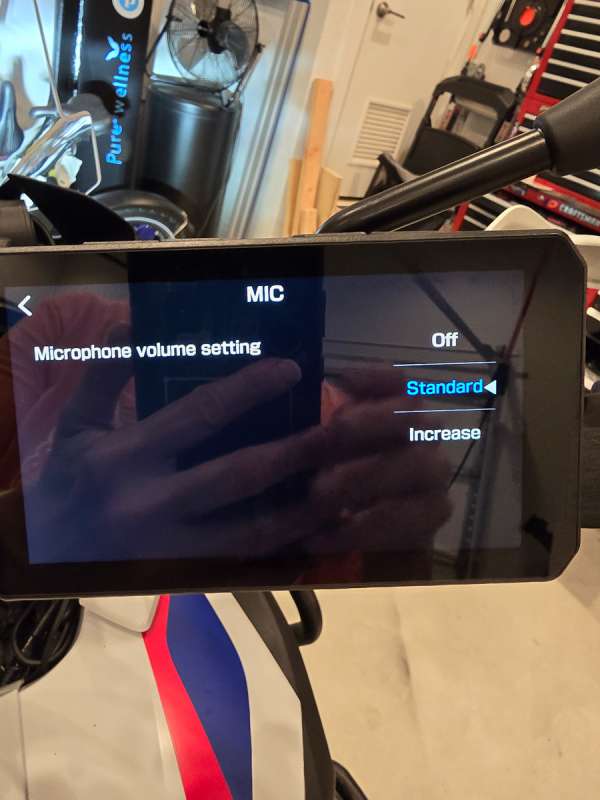
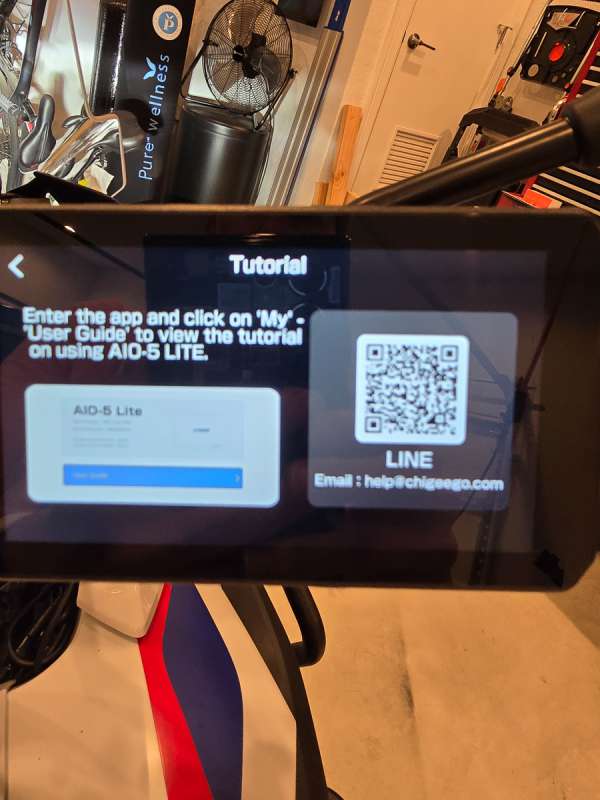
Assembly, Installation, Setup
Installing the AIO-5 Lite on a motorcycle can be quite an involved process. How long and difficult that will be depends on the type of motorcycle you ride and how clean of an install you want. As I mentioned before, I ride a BMW R1250 GS. This bike has plastic fairings on the side. Any cables running back to the battery or rear-mounted camera would be quite visible if I tried to run them outside the plastic.
Before diving into the major part of the installation, I needed to decide where to mount the display. Chigee has a mount that would place the display where my current navigation mount is sitting directly behind my windshield above the main display for the motorcycle. I don’t own the BMW Navigator, but I was unsure how much I would like the AIO-5 Lite. so I did not want to remove the existing navigation harness. I requested the mirror mount from Chigee and used that to install the display on my right-side view mirror.
The mirror ball mount connects to the back of the display with four screws. The part that connects the mirror to the ball mount attaches with two screws.
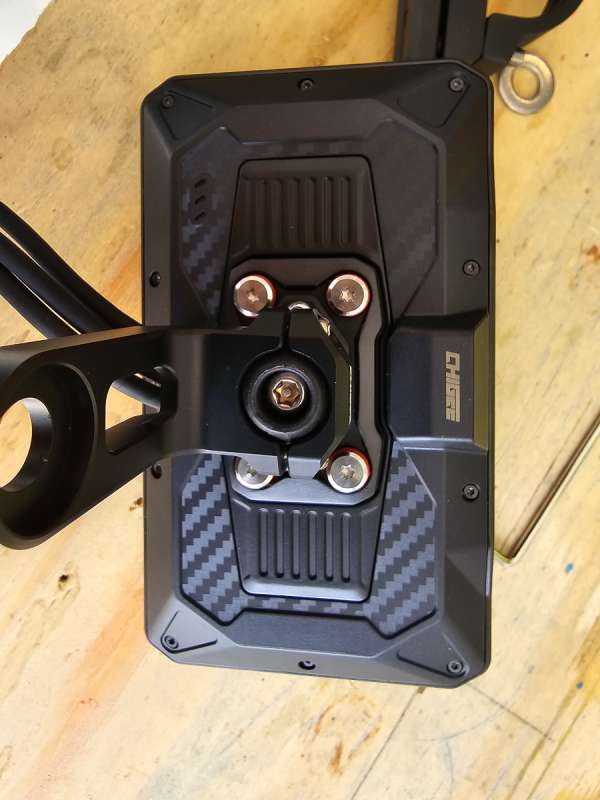
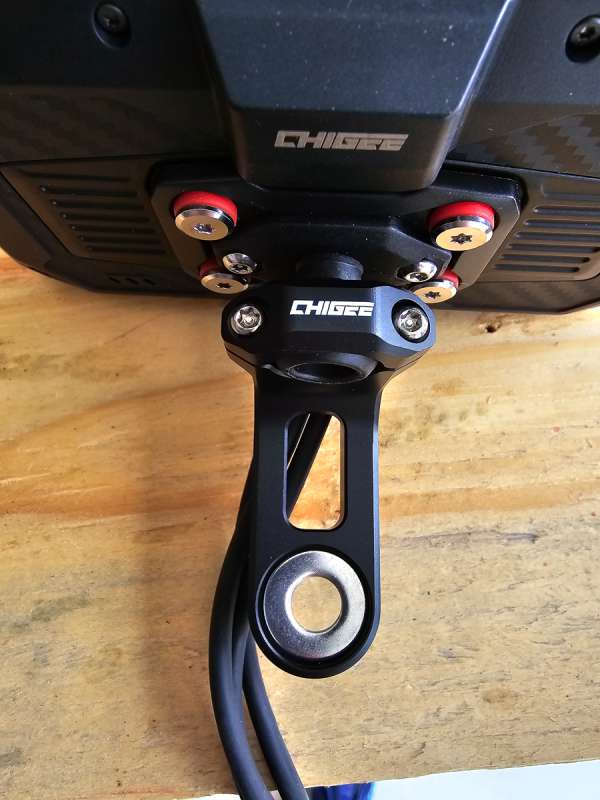
I unscrewed my right mirror and slid the mirror mount bracket over the top of the bolt. I then screwed the right mirror back in place. I then pushed the rubber cover back over the whole assembly. I think it made for a very clean installation. The mirror mount is a good option if you already have a crowded bar or your motorcycle does not even have a handlebar. Many sports bikes only have ‘clip-ons’ that do not provide a good place to mount things like this.
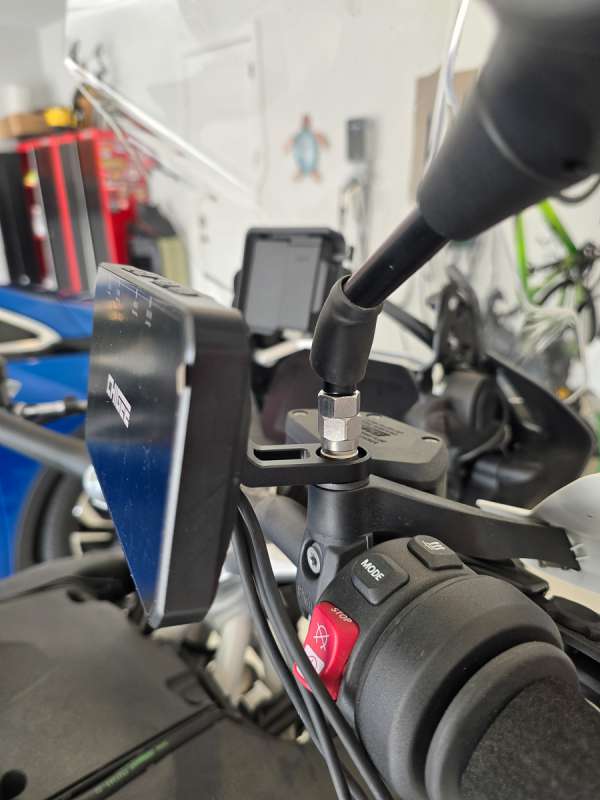
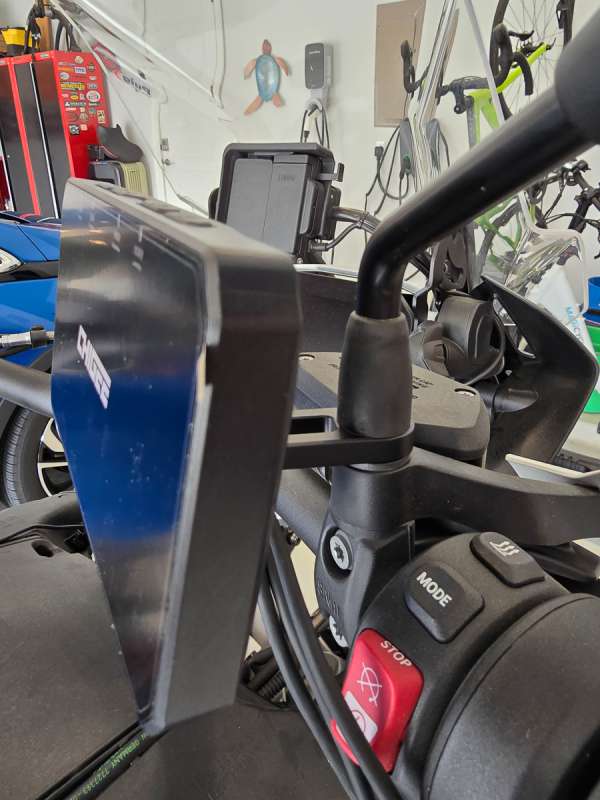
The next task was the most daunting for me. I have taken the fairings off several bikes in my 15 years of motorcycle ownership. However, I have never removed the gas tank from a motorcycle. I needed to remove the gas tank to get easier access to the harness, where I had to tap into an accessory power line. I also wanted to be able to run the lines for the power and rear camera so they were not visible at all once everything was put back together. Yay for YouTube. I found a great video that gave me step-by-step instructions on the best way to remove everything. Below is a picture of my motorcycle with all the fairings, seats, gas tank, and rear grab rails removed. I am happy to report every bolt found its way back to its proper place, and there were no ‘leftovers’!

The first thing I did was to install the BMW CANbus remote control into the tail of the motorcycle. Chigee made this very easy by providing a plug and play splitter that went into an existing harness in the back of the bike.
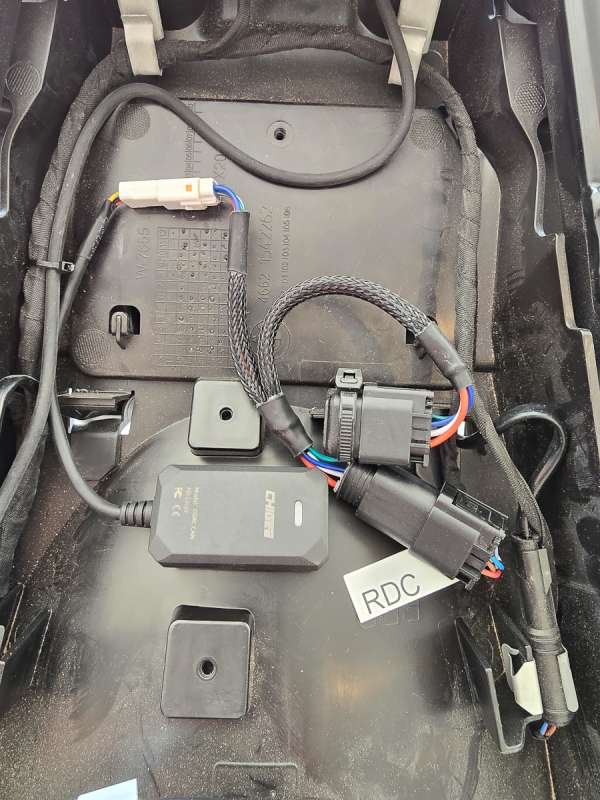
Next, I ran the two wires to the positive and negative poles on the battery. I then had to find an accessory wire that only received power when the bike started. That way, the display would come on when I turned the bike off and would not stay on when I turned the bike off. There was a harness right above the battery that had the line I needed. I used the included splicing buckle and tapped into the wire. I then used electrical tape to wrap up the harness again.
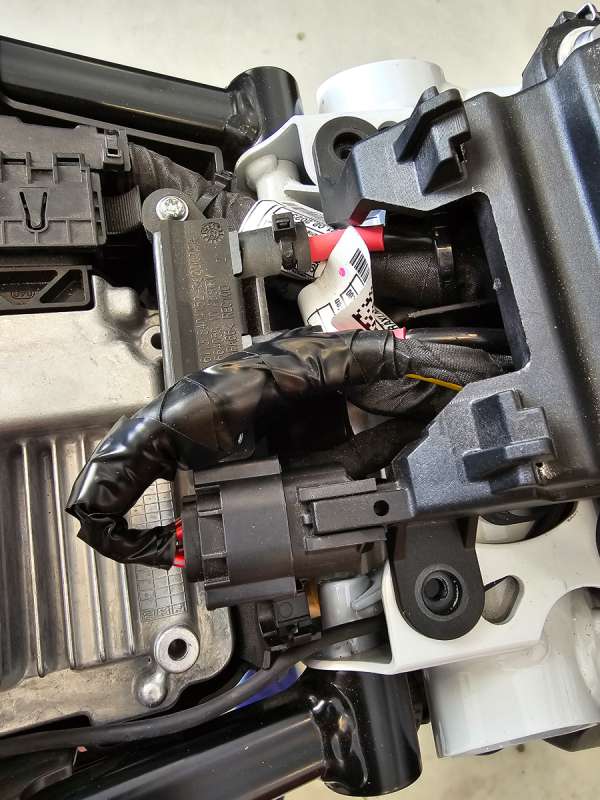
As I ran the wires through the bike, they all had to return to the main display. Each wire had a color-coded and marked connector on the main display. They each screwed into the opposing connector except for the GPS connector, which was pushed into place. I wrapped electrical tape around each connection to prevent accidental water issues.
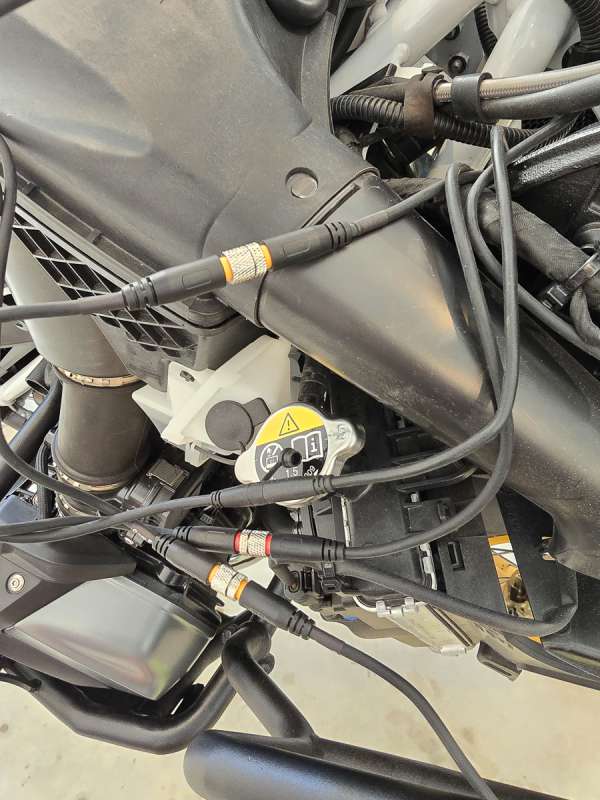
I mounted the rear camera just above my rear tail light. I used the included 3M double-sided tape. It has stayed in place so far. I will have to report how it handles our super hot summer temperatures.
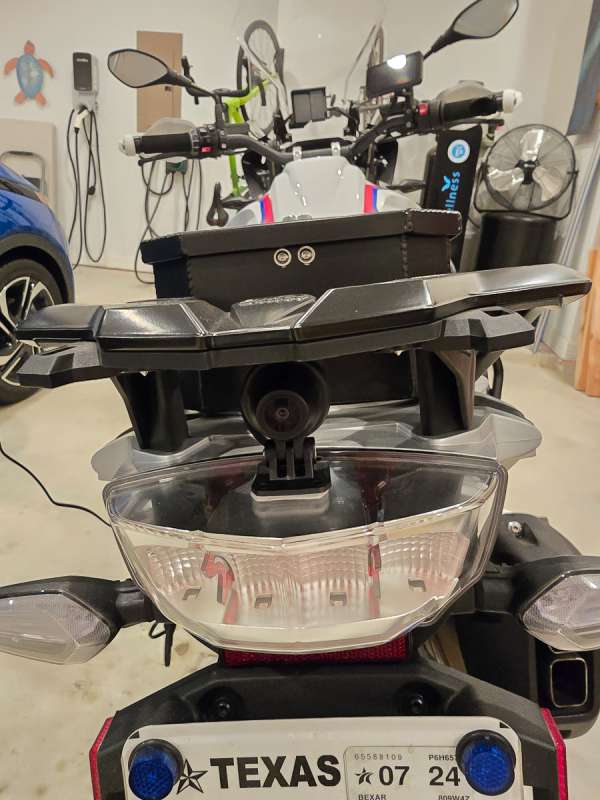
The front camera went on the fairing just under the headlight. You can also see the GPS unit right behind it.
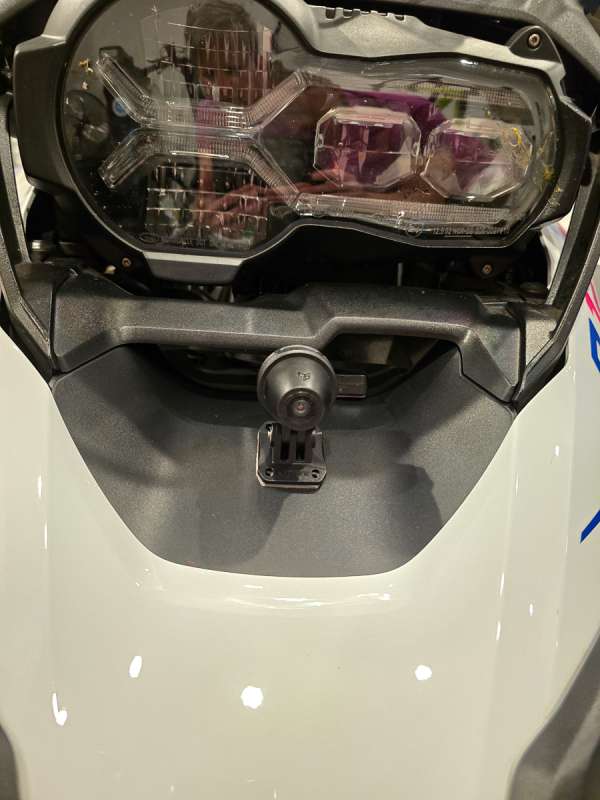
Here is a picture of my motorcycle all put back together. No wires visible!
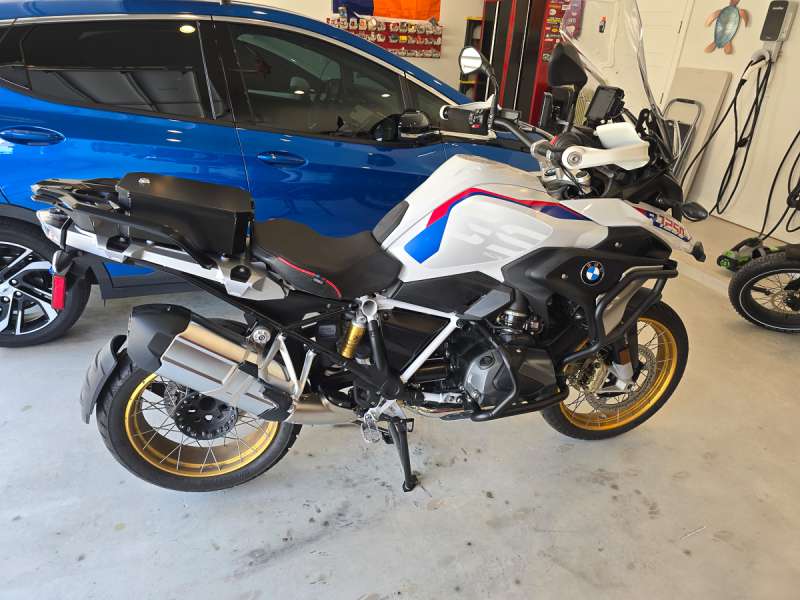
Here is a picture of the display on my handlebar. You can see the BMW navigation mount just above the bike’s LED display. If you have a GS without the navigation mount or want to simply remove it, Chigee makes a mount for the AIO-5 Lite to sit on that same bar.
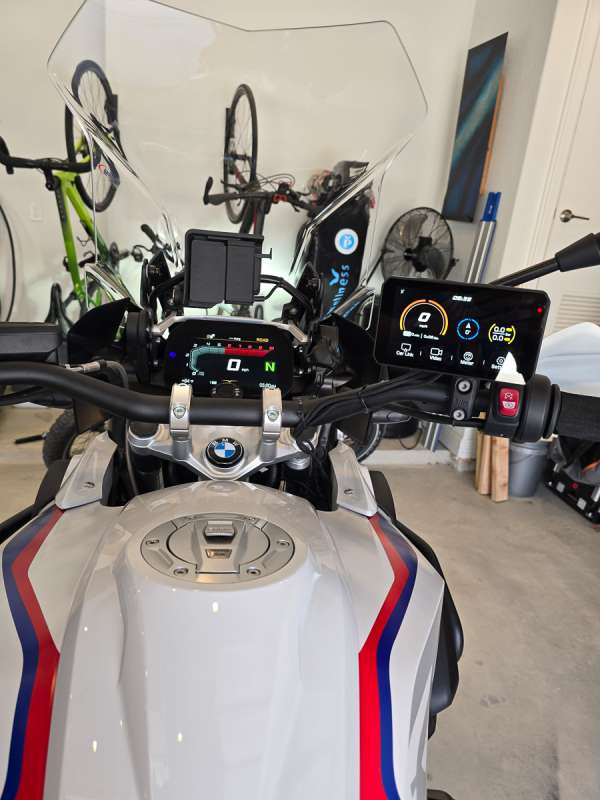
Performance
I have been really happy with the AIO-5 Lite. The screen is very responsive. Even with bulky winter gloves, it responds instantly to any touch on the screen. When I turn my bike on, it takes less than 30 seconds for the device to pair with my phone. I love using Spotify in Android Auto. I can easily pick a playlist and skip songs as needed. The display is nice and bright. Now, if I can only get my favorite navigation routing app to work on Android Auto like it does on Apple CarPlay, I know I could get rid of the BMW Navigation cradle. I often plan specific routes for rides that take us on back roads with beautiful scenery. Google Maps is great for getting from point A to point B, but if you want to take a specific route or some fun back roads, it won’t work for that.
The BMW CANbus remote worked great with the ‘wonder wheel’ on the bike. I could push the wheel left and right to scroll and select icons. The cancel button for the blinkers acted as the OK button.
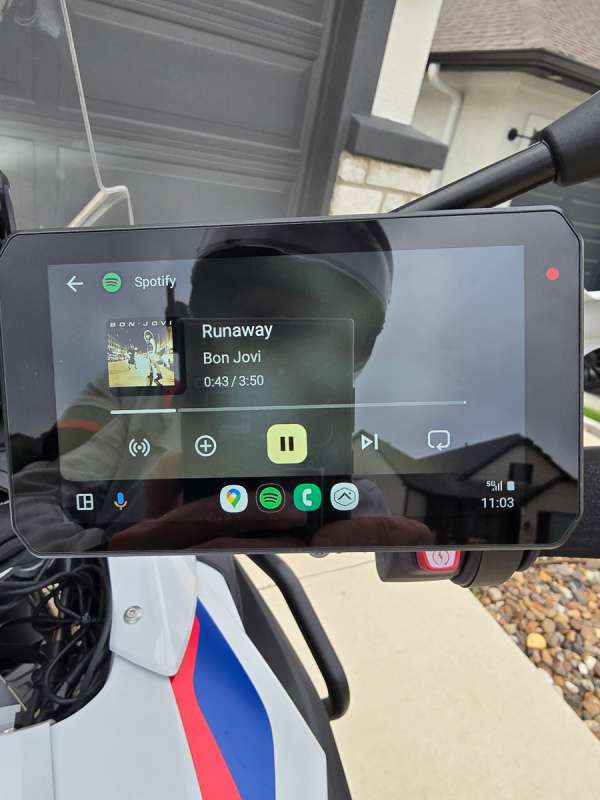
When I was riding, I noticed that the RPM did show, but not the engine temp or throttle. I believe that additional accessories will be required when they are available.

To access any stored videos, you have to either remove the SD card or connect to the device using the Chigee Go app. I downloaded the app and was able to connect to the device easily. I downloaded the front and rear videos.
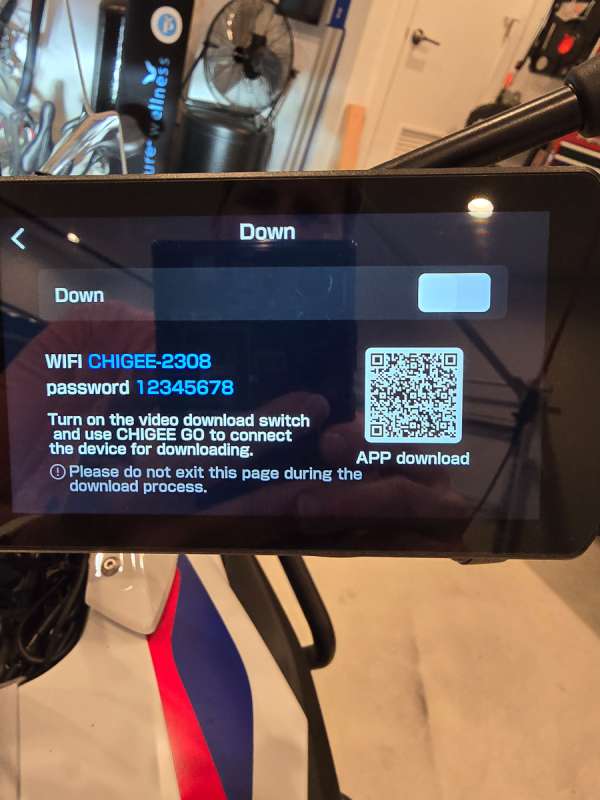
My friend and I went for a ride last weekend. It was a cloudy day, but the video came out very clearly. You can see my friend on her Yamaha VStar on the rear camera. Installing this system on her bike would be much easier since there are no fairings to remove. You may be able to install it by only removing the seat. I love having the cameras on the bike. I like the security they provide should something happen while I am riding. There are way too many inattentive drivers on the road today.
I will note that the blind spot detection worked okay. To be honest, I rarely have cars passing me. I tend to ride just faster than traffic, and the blind spot detection will only alert you when cars are coming up behind you, not when you are passing them. I also love that the speed indicated uses the GPS. Motorcycles often read high on speedometers, and I could confirm my speedo was reading a good 5mph higher than reality when I was going 70mph.
What I like about the Chigee AIO-5 Lite
- Even though it is ‘Lite’ it comes with two cameras and GPS.
- It has both Android Auto and Apple CarPlay
- Very responsive and speedy touch screen.
- Connects quickly to phone.
What needs to be improved?
- Nothing
Final thoughts
If you have a motorcycle and wish you had Android Auto/Apple CarPlay or cameras recording your ride, this is the tool for you. The ability to add a tire pressure monitoring system for bikes that don’t already have one is a bonus. I also love that they have a plug-and-play device that works with the BMW CANbus system to control it. The AIO-Lite is a well-built and responsive device. It can be some work to install, but it is worth the effort.
Price: $598.00
Where to buy: Chigee
Source: The sample of this product was provided for free by Chigee. Chigee did not have a final say on the review and did not preview the review before it was published.



Gadgeteer Comment Policy - Please read before commenting
How about both cameras quality? I was not able to read plates on the videos you uploaded easily.
Great video. I have one too. However, I haven’t gone in-depth with the camera settings. I’ll have to have a look and see what else that I can do with it.
Mine isn’t all that responsive to touchscreen presses with my gloves. I have 3 pairs; summer, winter-ish and winter ones which are battery heated. None of them work well with the touchscreen. I bought some adhesive contact patches for the fingers which has helped.
Carplay (Apple) works OK, too. I use an app called “Scenic” for my navigation and I have a Cardo Packtalk Edge helmet comms unit. In Carplay mode calls coming in pop up on the screen and I merely touch it to accept the call. This is heaps better than trying to remember which of the tiny buttons on the Cardo that I have to push to accept the call and it’s safer, too.
While Scenic does act as a basic trip computer I wish that the Chigee would add more data to its trip computer screen. Currently it shows OBD data which I cannot use as I don’t have a BMW (Suzuki V-Strom 1050XT). I’d like to be able to edit that screen to include the info that I’d like to see and to record for each trip.
Screen size is OK but a friend installed a 7″ Carpuride unit on his F850 ADV. Looks heaps better, but it’s only function is as a Carplay/Android Auto unit, whereas the smaller (and far more expensive) Chigee has cameras, a GPS for the built-in speedo as well as tyre pressure monitors which work well.
Yep, I’m happy with it. It’s expensive but in time it should drop in price as it gains market share.